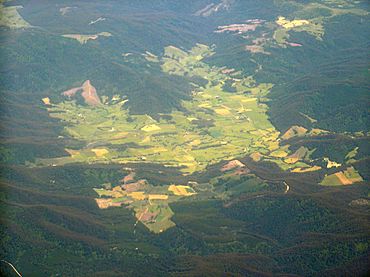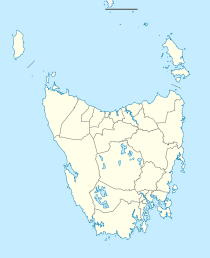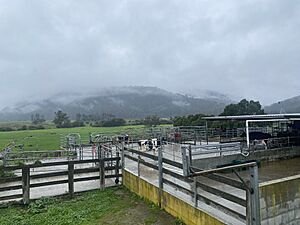Pyengana facts for kids
Quick facts for kids PyenganaTasmania |
|
|---|---|

Aerial photo of Pyengana region
|
|
| Population | 123 (2006 census) |
| Postcode(s) | 7216 |
| LGA(s) | Break O'Day Council |
| State electorate(s) | Lyons |
| Federal Division(s) | Lyons |
Pyengana is a small village located in the north-east part of Tasmania, Australia. A village is a small community, usually smaller than a town. In 2006, about 123 people lived in Pyengana.
This area is mostly a farming region. It is known for its beautiful natural spots and interesting historical places. Pyengana is part of the Break O'Day Council, which is like its local government area. The closest bigger town, called a regional centre, is St Helens, about 27 kilometres away.
Contents
History of Pyengana
People started living in Pyengana permanently around 1875. Some of the first families to settle here were George and Margaret Cotton. They had nine children and lived on a property they named St Columba.
The first post office in the area opened on December 1, 1885. It was first called Georges River Post Office. A few years later, in 1888, its name was changed to Pyengana.
The region was also important for mining. There were several tin mines, like the Anchor Tin Mine. These mines helped the area grow in the past.
Amazing Natural Places
Pyengana is home to some stunning natural sights. These places are great for exploring and enjoying nature.
St Columba Falls: A Giant Waterfall
One of the most famous spots is St Columba Falls. This is a very tall waterfall where water cascades down. The highest part of the waterfall drops about 90 metres! It's an impressive sight to see.
Halls Falls and Blue Tier
Other beautiful natural areas include Halls Falls, another lovely waterfall. You can also visit the Blue Tier, which is a mountain range. These places offer great opportunities for hiking and enjoying the outdoors.
Local Businesses and Products
Pyengana is known for some special local businesses. They produce unique items and offer interesting experiences.
Pyengana Cheese Factory: Delicious Cheddar
The area is famous for the Pyengana Cheese Factory. This factory is run by the Healey family, who have been making cheese for four generations! They are especially known for their delicious cloth-bound cheddar cheese.
The Pub in the Paddock: A Unique Pub
Another well-known place is the 'Pub in the Paddock'. It was built in 1900 and is literally a pub located inside a farm paddock! It used to have a famous pig that enjoyed drinking beer. That pig has passed away, but there's a new pig there now that also likes to have a drink, but only when the owner brings it to them.
Anchor Farms: Organic Potatoes
Anchor Farms started growing special organic potatoes in 1995. Now, they supply their gourmet potatoes all over Australia. They even export them to countries in Southeast Asia.



